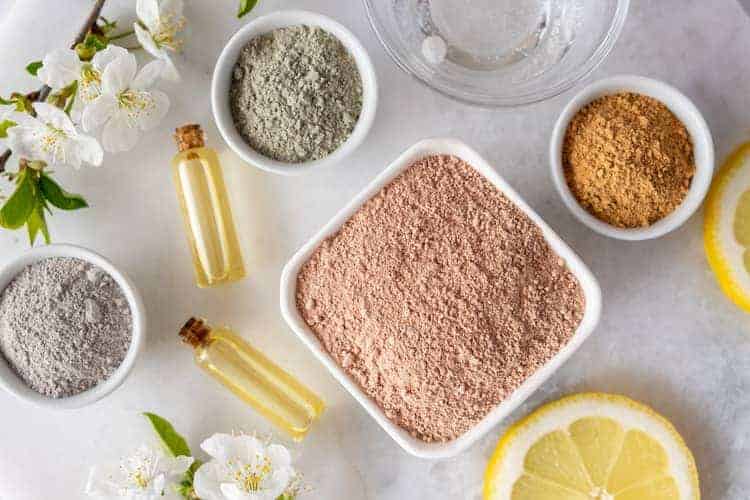
When creating a natural skin care routine for dry skin, it’s important to focus on ingredients that:
- Hydrate: this means water-based products, especially those that contain humectants (since they draw moisture to the skin).
- Occlude: these are mainly oils and butters that create a protective barrier on the skin. The barrier is essential for slowing down the evaporation of water.
- Exfoliate: gentle exfoliants help to lift off dead, flaky skin. For dry skin, it’s best to skip manual exfoliants (like sugar scrubs) and go for gentler, chemical exfoliants.
- Soothe inflammation: dry skin can sometimes show signs of inflammation (redness, itchiness or even, acne). Anti-inflammatory ingredients are important for soothing those symptoms.
To help you apply the above guidelines to your daily life, this article is going to walk you through:
- the basic steps of a day-time and night-time natural skin care routine for dry skin.
- ingredients to use (many of these are probably already in your kitchen or medicine cabinet).
- a simple hack that you can use to improve dry skin overnight.
Note: this post contains affiliate links and I earn a commission (at no additional cost to you) if you use them to make a purchase.
BEST NATURAL SKIN CARE ROUTINE FOR DRY SKIN
1. Gentle Cleanser
A gentle cleanser that won’t strip the skin of its natural oils is essential for cleaning dry skin.
Some of the best choices include:
- Raw honey: this can be manuka honey or any raw honey that you can get your hands on. To learn how to use honey as a face wash, read this guide to using honey for face.
- Micellar water: this is a gentle, water-based cleanser that contains very mild surfactants. It’s a much gentler alternative to soap or standard cleansers/
- Double cleansing: this two-step process involves the use of a cleansing oil, cleansing balm or micellar water followed by a water-based cleanser. This guide on how to double cleanse walks you through exactly how to incorporate it into your daily routine.
2. Soothing Mask
There are two types of masks that are ideal for dry skin:
- A hydrating mask made from ingredients like honey, oatmeal or aloe vera.
- A gentle exfoliating mask made from ingredients like green tea, aloe vera or a gentle clay like kaolin (check out this guide for tips on how to use a kaolin clay mask for dry skin).
3. Hydrating and Balancing Toner
One of the best toners to use on dry skin is rose water because it hydrates the skin, keeps the skin supple and contains antioxidants that are soothing to the skin.
Another great alternative is a green tea toner which is packed with soothing antioxidants that may even help with severe dry skin conditions like psoriasis (source).
5. Moisturize
Depending on your personal preferences, moisturizing dry skin can include the following steps (listed in the order in which you layer products):
- Serum: a hyaluronic acid serum is one of the best choices for dry skin because it has humectant properties that draw moisture to the skin. In addition, dry skin can also benefit from a gentle vitamin C serum (formulated with hydrating ingredients). This helps to exfoliate the skin and also stimulates the fibroblasts (these are the cells that produce hyaluronic acid and collagen).
- Moisturizer: water-based moisturizers formulated with humectants (glycerin, honey or hyaluronic acid) are the easiest option here.
- Carrier oil: squalane and jojoba oil are two easy-to-find oils that are ideal for sealing in moisture.
In addition, your eye cream can be included in this step (or you can also use your favorite carrier oil around the eyes).
6. Protect with Sunscreen
If your moisturizer from the previous step contains sunscreen, then you can skip this step.
Otherwise, for the day time, be sure to apply sunscreen as the final step in your routine (before makeup).
Now that we’ve covered the essentials, here are some ingredients and products that you can use to treat dry skin naturally.
| Bioderma Sensibio Micellar Water | GET IT HERE |
| Cleansing balm (for double cleansing) | GET IT HERE |
| Manuka Honey | GET IT HERE |
| Vegetable glycerin | GET IT HERE |
| Shea butter | GET IT HERE |
| Rose water | GET IT HERE |
| Green tea toner with hyaluronic acid | GET IT HERE |
| Jojoba oil | GET IT HERE |
| Squalane oil | GET IT HERE |
| Kaolin clay | GET IT HERE |
| Vitamin C Serum with Hyaluronic Acid | GET IT HERE |
NATURAL NIGHT SKIN CARE ROUTINE FOR DRYNESS

The minimum requirement for a good, natural, night-time skin care routine for dry skin is a gentle cleanser and a moisturizer.
In addition, the evening is the perfect time to give your skin an extra dose of moisturization through the practice of slugging.
If you’re not familiar with slugging, it involves applying a heavy occlusive as the final step in your skin care routine.
When done correctly, it can do wonders for quickly restoring moisture to dry skin.
Here’s my favorite way to do slugging:
- Cleanse your face.
- Get a 10-ounce spray bottle (like this one). Fill it most of the way with distilled or filtered water.
- Add 1 tablespoon of vegetable glycerin. Seal and shake to mix everything together.
- Mist your face with the water-glycerin mixture.
- Cover your face with one of the following occlusive agents: petroleum jelly, shea butter or any carrier oil of your choice.
Go to sleep and be prepared for much more moisturized and supple skin the next morning!
NOTE: heavy occlusive agents like petroleum jelly and shea butter will deliver the best results. But if you’re just not a fan of putting those on your face, then any carrier oil will do (though the effects won’t be as strong).
TIPS ON CREATING A NATURAL BEAUTY ROUTINE FOR DRY, ACNE-PRONE SKIN
If your skin is both dry and acne-prone, the general guidelines listed above are still applicable for you.
However, when it comes to addressing the acne side of things, it’s important to avoid harsh ingredients that can add to dryness or irritation. This includes things like:
- benzoyl peroxide.
- rubbing alcohol (aka isopropyl alcohol).
- witch hazel that is extracted in alcohol (use water-based witch hazel instead).
- retinoids.
- acids such as salicylic acid or glycolic acid.
- fragrance (particularly synthetic fragrance).
Instead, lean on the following natural ingredients to address acne:
- turmeric.
- green tea.
- honey.
- carrier oils (particularly jojoba and rosehip).
- aloe vera.
- tea tree oil (always dilute with a carrier oil).
- herbs like chamomile, comfrey, licorice
- gentle clays like white kaolin.
FAQs ABOUT ORGANIC SKIN CARE ROUTINE FOR DRY SKIN
Is vitamin E oil good for dry skin?
Vitamin E oil is an excellent emollient and can help to soften dry skin. It also has antioxidant properties that can help to soothe the irritation often associated with dry skin.
Is coconut oil good for dry skin?
Coconut oil’s anti-inflammatory properties can be soothing to dry skin. In addition, coconut oil is heavier than liquid carrier oils. This means it has stronger occlusive properties that help to slow down water loss from the skin.
Which oil is best for dry skin?
Some of the best oils for dry skin include apricot kernel, avocado, rosehip, sea buckthorn, almond, sunflower and argan oil.
Is lemon good for dry skin?
Pure lemon is quite acidic and also contains citric acid, which is one of the harshest forms of vitamin C (which is why citric acid isn’t normally used in vitamin C skin care products). So, using pure lemon can potentially irritate the skin and worsen dryness.
Is coffee good for dry skin?
Although a coffee scrub is a good homemade exfoliant, the grains may be too irritating for dry skin. A better and gentler manual scrub for dry skin is colloidal oatmeal or “chemical” exfoliants like aloe vera and green tea.
How come my face is so dry?
Dry skin can occur for lots of reasons including:
- using cleansers that remove too much of the skin’s natural oils.
- having a poor diet that makes it difficult for the skin to produce sufficient oils or stay hydrated.
- living a climate that is either too hot or too cold, with low humidity.
- taking showers with water that is too hot.
- using too many harsh ingredients in your skin care routine.
CONCLUSION
When creating a homemade or natural skin care routine for dry skin, the main priorities are hydration and protection (which includes a good oil to seal in moisture and protect the skin barrier).
I hope this article has helped you get a better understanding of how you can improve dry skin at home with a just a few natural ingredients.
Best Vitamin C Serums for Dry Skin
15 Best Natural Ingredients For Dry Skin On Face
Kaolin Clay Mask for Dry Skin: Benefits and Tips For A Healthy Glow
Best Carrier Oils for Sensitive Skin: 10 Oils To Soothe Dryness, Acne, Cracked Skin & More

